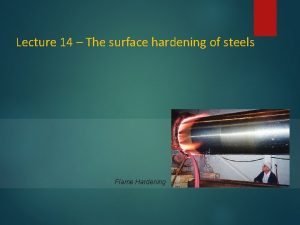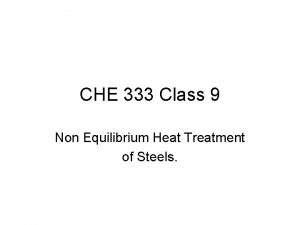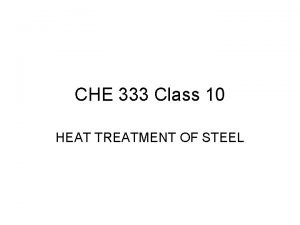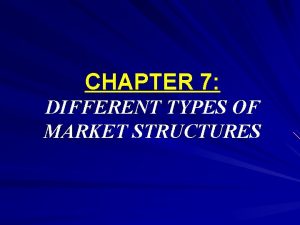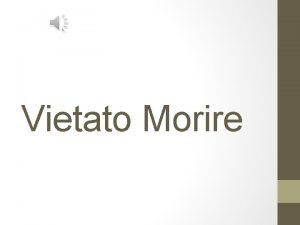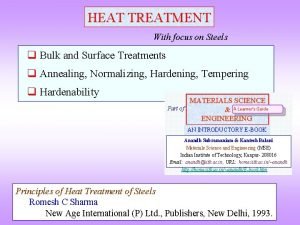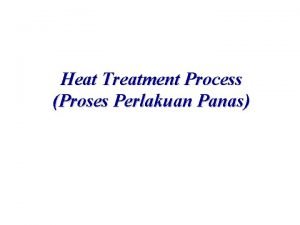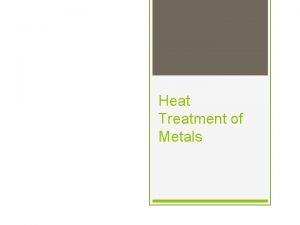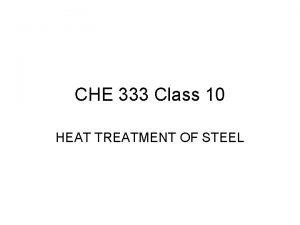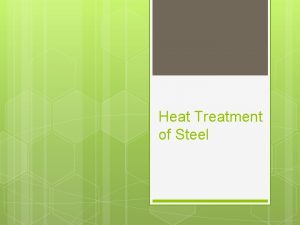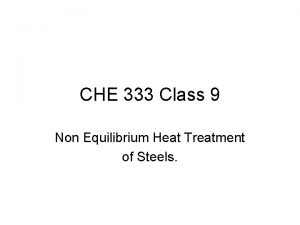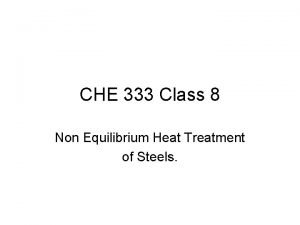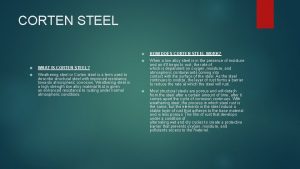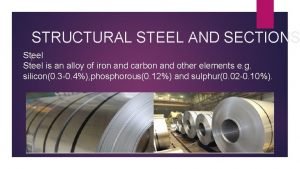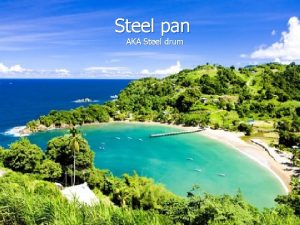CHE 333 Class 9 HEAT TREATMENT OF STEEL













- Slides: 13

CHE 333 Class 9 HEAT TREATMENT OF STEEL

EXAM • Material Covered – Up to and including class 7, along with labs 1, 2 and 3. • Multiple choice questions.

What and Why Heat Treat? HEAT TREATMENT is THERMAL PROCESSING to OPTIMISE MECHANICAL PROPERTIES. By heat treatment a 10 to 1 ratio can be achieved between maximum and minimum strength levels. At the same time a 50 to 1 ratio of ductility can be achieved. Thermal Treatments range from quenching to long holds, 24 hours, at a fixed temperature. In all cases thermal processing controls the microstructure and so also the mechanical properties.

Starting Point • Heat treatment usually includes a quench treatment. Therefore the starting point will be a fully martensitic steel. The steel composition will usually have some alloy additions, mainly a group of elements called “carbide formers”. These include Cr, Mo, W, V, Ti, Co. • These will be active in the “tempering” process after quenching.

Steel Compositions. • 1095 - 98. 755 -98. 355 Fe, . 90 -1. 05 C, . 25 -. 50 Mn, . 040 P, . 055 S – Plain • 3140 - 97. 51 -96. 31 Fe, . 35 -. 45 C, . 45 -. 75 Cr, . 60 -. 90 Mn, 1. 00 -1. 50 Ni, . 040 P, . 050 S - Cr & Ni • 4140 - 98. 01 -97. 21 Fe, . 35 -. 45 C, . 60 -. 90 Mn, . 80 -1. 10 Cr, . 15 -. 25 Mo, . 040 P, . 050 S – Cr & Mo • 4340 - 96. 76 -95. 46 Fe, . 35 -. 45 C, . 60 -. 90 Cr, . 50 -. 80 Mn, . 20 -. 30 Mo, 1. 50 -2. 00 Ni, . 040 P, . 050 S – Cr & Mo & Ni

Hardenability of a Steel Hardenability is the ability of a steel to form martensite. The greater the hardenabillity the more martensite. Note the difference between hardness and hardenabilty. Hardness is used to measure hardenability. A steel rod is cooled rapidly from one end in a Jominy test and the hardness measured as a function of distance from the quenched end. The decrease in hardness gives the hardenability. For the three steels 1040, 4140 and 4340, the hardness drops rapidly after 5 mm for the 1040 so it has low hardenabilty. The 4340 has much better hardenability. The hardness of martensite depends on The carbon content as 1060 has 0. 6%C and 1080 has 0. 8%C. Quench media, grain size, bar diameter affect the measurements.

APPLICATION OF HARDENABILITY Applications of Hardenability Include 1. Choosing steels that need to have a uniform microstructure after quenching 2. Components needing a dual microstructure, such as car axles, where a hard surface to withstand a bearing is combined with a softer tougher center so that failure will be ductile. Low hardenability can be used in this case to only form hard martensite on the surface. Another example would be gears. In this application, induction hardening followed by quenching surface hardens the gears and leaves a soft ductile core.

TEMPERING OF MARTENSITE After quenching to form martensite, a strong but brittle material is produced. For many Applications a weaker but more tough or ductile material is needed so quenched, Martensitic steels are Tempered to reduce strength but increase ductility. During tempering, carbide in the form of small particles are formed as the steel tries to go back to its equilibrium phases. These carbide compositions involve the carbide formers, Mo, W, Cr, Ti, V. Tempering temperatures and times are set at values that favour the formation of these carbides.

Tempering Martensite. Tempering is holding the steel below the eutectoid temperature of 727 C for a period of time. During this period, the martensite, transforms to two phase a + carbide. The specific carbide depends on the steel composition. Note the tempering temperature controls the service temperature of the steel. A 4340 steel is austenitized at 1650 F, quenched into oil and tempered at 325 F for 1 hour to give a yield strength of 230, 000 psi. Temper embrittlement is a range of tempering where the steel becomes brittle after tempering. The temperature range is 350 to 500 F, which produces hardnesses of 48 to 42 Rockwell C scale. The higher the temperature or the longer the time, the lower the strength, the greater the ductility and the higher the elongation to failure. This enables steel properties to be controlled to particular desirable ranges.

Spherodized Structure Holding pearlite for 24 hours at 650 C leads to a Spherodized structure as the carbides form large particles. This is the softest and weakest steel, Rc is 8. 5, yield strength around 30, 000. The idea is to machine in the soft condition where minimum effort is required, then heat treat to reach the strength required of the component.

Heat Treatment Terms. Annealing – heat treating to produce a soft structure. Normalizing – air cooling after high temperature exposure Full Anneal – furnace cooling after high temperature exposure – very slow cool Process Anneal – an anneal conducted during processing Bright Anneal – control atmosphere to stop oxidation process. Controlled atmosphere annealing – control the atmosphere while heating. Produces specific surface compositions. Cautions – surface condition changes, due to oxidation and composition changes as elements diffuse from the surface e. g. decarburization. distortion – piece changes shape during annealing, especially after working.

Steel Compositions American Iron and Steel Institute (AISI), Society of Automotive Engineers (SAE), Unified Numbering System (UNS), and Mil Spec are all different methods of classifying steels. AISI is most common. Last two digits are the carbon content. For example XX 20 is 0. 2%C, XX 80 is 0. 8%C. The first two digits are the alloy additions, For example 1020 is a plain carbon steel, while a 4340 steel is the Nickel, Chrome Molybdenum series. All these steel have manganese added to pick up sulfur as Mn. S inclusions. Tool steels have a different AISI series depending how the steel is hardened.

Steel Compositions Stainless Steels have series, such as 300, 400. 300 series is for steels that are austenitic at room temperature, 304 is common which is Fe 19 Cr 9 Ni 0. 08%C – note the very low carbon content. The 400 series are lower on nickel and so are ferritic unless quenched when they become martensitic. 440 A is Fe 17 Cr, 1 Mn, 1 Si, 0. 75 Mo, 0. 7 C, 0. 3 S and 0. 04. Grades of this are A (0. 7 C), B (0. 85 C)and C(1. 0 C) with increasing carbon content. Also have 17 4 p. H for Precipitation Hardening. In this case the austenite is metastable at room temperature after quenching and decomposes during ageing. Composition is Fe with C 0. 040, Cr 15. 50, Co + Ta 0. 30, Cu 3. 50, Mn 0. 40, Ni 4. 50, P 0. 020, Si 0. 50, S 0. 0050
 Flame hardening steel
Flame hardening steel Che 333
Che 333 Che 333
Che 333 Monopolistic competition examples
Monopolistic competition examples Proposizioni oggettive esplicite
Proposizioni oggettive esplicite Ricordo quegli occhi pieni di vita
Ricordo quegli occhi pieni di vita Che che kooley
Che che kooley Facesti come quei che va di notte che porta il lume
Facesti come quei che va di notte che porta il lume Stainless steel heat exchanger tube
Stainless steel heat exchanger tube Salt water pool heat exchanger
Salt water pool heat exchanger Wholesale hardening and tempering
Wholesale hardening and tempering Heat treatment process
Heat treatment process Normalizing heat treatment
Normalizing heat treatment Heat treatment cost calculator
Heat treatment cost calculator
